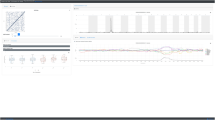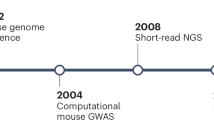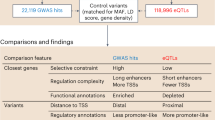Abstract
Here we present a strategy to determine the genetic basis of variance in complex phenotypes that arise from natural, as opposed to induced, genetic variation in mice. We show that a commercially available strain of outbred mice, MF1, can be treated as an ultrafine mosaic of standard inbred strains and accordingly used to dissect a known quantitative trait locus influencing anxiety. We also show that this locus can be subdivided into three regions, one of which contains Rgs2, which encodes a regulator of G protein signaling. We then use quantitative complementation to show that Rgs2 is a quantitative trait gene. This combined genetic and functional approach should be applicable to the analysis of any quantitative trait.
This is a preview of subscription content, access via your institution
Access options
Subscribe to this journal
Receive 12 print issues and online access
$259.00 per year
only $21.58 per issue
Buy this article
- Purchase on SpringerLink
- Instant access to full article PDF
Prices may be subject to local taxes which are calculated during checkout


Similar content being viewed by others
References
Flint, J. & Mott, R. Finding the molecular basis of quantitative traits: successes and pitfalls. Nat. Rev. Genet. 2, 438–445 (2001).
Flint, J. Analysis of quantitative trait loci that influence animal behavior. J. Neurobiol. 54, 46–77 (2003).
Gershenfeld, H.K. & Paul, S.M. Mapping quantitative trait loci for fear-like behaviors in mice. Genomics 46, 1–8 (1997).
Turri, M.G., De Fries, J.C., Henderson, N.D. & Flint, J. Multivariate analysis of quantitative trait loci influencing variation in anxiety-related behavior in laboratory mice. Mamm. Genome 15, 69–76 (2004).
Henderson, N.D., Turri, M.G., DeFries, J.C. & Flint, J. QTL analysis of multiple behavioral measures of anxiety in mice. Behav. Genet. 34, 267–293 (2004).
Turri, M.G., Henderson, N.D., DeFries, J.C. & Flint, J. Quantitative trait locus mapping in laboratory mice derived from a replicated selection experiment for open-field activity. Genetics 158, 1217–1226 (2001).
McClearn, G.E., Wilson, J.R. & Meredith, W. The use of isogenic and heterogenic mouse stocks in behavioral research. in Contributions to Behavior-Genetic Analysis: The Mouse as a Prototype (eds. Lindzey, G. & Thiessen, D.) 3–22 (Appleton Century Crofts, New York, 1970).
Mott, R., Talbot, C.J., Turri, M.G., Collins, A.C. & Flint, J. A method for fine mapping quantitative trait loci in outbred animal stocks. Proc. Natl. Acad. Sci. USA 97, 12649–12654 (2000).
Talbot, C.J. et al. High-resolution mapping of quantitative trait loci in outbred mice. Nat. Genet. 21, 305–308 (1999).
Yalcin, B. et al. Unexpected complexity in the haplotypes of commonly used inbred strains of laboratory mice. Proc. Natl. Acad. Sci. USA 101, 9734–9739 (2004).
Nobrega, M.A., Ovcharenko, I., Afzal, V. & Rubin, E.M. Scanning human gene deserts for long-range enhancers. Science 302, 413 (2003).
Higgs, D.R. et al. A major positive regulatory region located far upstream of the human α-globin gene locus. Genes Dev. 4, 1588–1601 (1990).
Lettice, L.A. et al. Disruption of a long-range cis-acting regulator for Shh causes preaxial polydactyly. Proc. Natl. Acad. Sci. USA 99, 7548–7553 (2002).
Aitman, T.J. et al. Quantitative trait loci for cellular defects in glucose and fatty acid metabolism in hypertensive rats. Nat. Genet. 16, 197–201 (1997).
Tafti, M. et al. Deficiency in short-chain fatty acid β-oxidation affects τ oscillations during sleep. Nat. Genet. 34, 320–325 (2003).
Gross, C. et al. Serotonin1A receptor acts during development to establish normal anxiety-like behaviour in the adult. Nature 416, 396–400 (2002).
Lai, C., Lyman, R.F., Long, A.D., Langley, C.H. & Mackay, T.F. Naturally occurring variation in bristle number and DNA polymorphisms at the scabrous locus of Drosophila melanogaster . Science 266, 1697–1702 (1994).
De Luca, M. et al. Dopa decarboxylase (Ddc) affects variation in Drosophila longevity. Nat. Genet. 34, 429–433 (2003).
Zhang, Y. et al. Positional cloning of a quantitative trait locus on chromosome 13q14 that influences immunoglobulin E levels and asthma. Nat. Genet. 34, 181–186 (2003).
Helms, C. et al. A putative RUNX1 binding site variant between SLC9A3R1 and NAT9 is associated with susceptibility to psoriasis. Nat. Genet. 35, 349–356 (2003).
Ueda, H. et al. Association of the T-cell regulatory gene CTLA4 with susceptibility to autoimmune disease. Nature 423, 506–511 (2003).
Tokuhiro, S. et al. An intronic SNP in a RUNX1 binding site of SLC22A4, encoding an organic cation transporter, is associated with rheumatoid arthritis. Nat. Genet. 35, 341–348 (2003).
Long, A.D., Mullaney, S.L., Mackay, T.F.C. & Langley, C.H. Genetic interactions between naturally occurring alleles at quantitative trait loci and mutant alleles at candidate loci affecting bristle number in Drosophila melanogaster . Genetics 144, 1497–1510 (1996).
Steinmetz, L.M. et al. Dissecting the architecture of a quantitative trait locus in yeast. Nature 416, 326–330 (2002).
Beck, J.A. et al. Genealogies of mouse inbred strains. Nat. Genet. 24, 23–25 (2000).
Stephens, M. & Donnelly, P. A comparison of Bayesian methods for haplotype reconstruction from population genotype data. Am. J. Hum. Genet. 73, 1162–1169 (2003).
Stephens, M., Smith, N.J. & Donnelly, P. A new statistical method for haplotype reconstruction from population data. Am. J. Hum. Genet. 68, 978–989 (2001).
Talbot, C.J. et al. Fine scale mapping of a genetic locus for conditioned fear. Mamm. Genome 14, 223–230 (2003).
Oliveira-Dos-Santos, A.J. et al. Regulation of T cell activation, anxiety, and male aggression by RGS2. Proc. Natl. Acad. Sci. USA 97, 12272–12277 (2000).
Wade, C.M. et al. The mosaic structure of variation in the laboratory mouse genome. Nature 420, 574–578 (2002).
Lindblad-Toh, K. et al. Large-scale discovery and genotyping of single-nucleotide polymorphisms in the mouse. Nat. Genet. 24, 381–386 (2000).
Wiltshire, T. et al. Genome-wide single-nucleotide polymorphism analysis defines haplotype patterns in mouse. Proc. Natl. Acad. Sci. USA 100, 3380–3385 (2003).
Hitzemann, R. et al. Multiple cross mapping (MCM) markedly improves the localization of a QTL for ethanol-induced activation. Genes Brain Behav. 1, 214–222 (2002).
Plomin, R., McClearn, G.E., Gora-Maslak, G. & Neiderhiser, J.M. Use of recombinant inbred strains to detect quantitative trait loci associated with behavior. Behav. Genet. 21, 99–116 (1991).
Turri, M.G., Datta, S.R., DeFries, J., Henderson, N.D. & Flint, J. QTL analysis identifies multiple behavioral dimensions in ethological tests of anxiety in laboratory mice. Curr. Biol. 11, 725–734 (2001).
Grafstein-Dunn, E., Young, K.H., Cockett, M.I. & Khawaja, X.Z. Regional distribution of regulators of G-protein signaling (RGS) 1, 2, 13, 14, 16, and GAIP messenger ribonucleic acids by in situ hybridization in rat brain. Brain Res. Mol. Brain Res. 88, 113–123 (2001).
Dong, M.Q., Chase, D., Patikoglou, G.A. & Koelle, M.R. Multiple RGS proteins alter neural G protein signaling to allow C. elegans to rapidly change behavior when fed. Genes Dev. 14, 2003–2014 (2000).
Rahman, Z. et al. RGS9 modulates dopamine signaling in the basal ganglia. Neuron 38, 941–952 (2003).
Heximer, S.P. et al. Hypertension and prolonged vasoconstrictor signaling in RGS2-deficient mice. J. Clin. Invest. 111, 445–452 (2003).
Huang, Z.P. et al. Expression of regulator of G-protein signalling protein 2 (RGS2) in the mouse uterus at implantation sites. Reproduction 126, 309–316 (2003).
Legare, M.E., Bartlett, F.S. & Frankel, W.N. A major effect QTL determined by multiple genes in epileptic EL mice. Genome Res. 10, 42–48 (2000).
Wanstrat, A. & Wakeland, E. The genetics of complex autoimmune diseases: non-MHC susceptibility genes. Nat. Immunol. 2, 802–809 (2001).
Fijneman, R.J., de Vries, S.S., Jansen, R.C. & Demant, P. Complex interactions of new quantitative trait loci, Sluc1, Sluc2, Sluc3, and Sluc4, that influence the susceptibility to lung cancer in the mouse. Nat. Genet. 14, 465–467 (1996).
van Wezel, T., Ruivenkamp, C.A., Stassen, A.P., Moen, C.J. & Demant, P. Four new colon cancer susceptibility loci, Scc6 to Scc9 in the mouse. Cancer Res. 59, 4216–4218 (1999).
Mackay, T.F. The genetic architecture of quantitative traits: lessons from Drosophila . Curr. Opin. Genet. Dev. 14, 253–257 (2004).
Flint, J., De Fries, J.C. & Henderson, N.D. Little epistasis for anxiety-related measures in the DeFries strains of laboratory mice. Mamm. Genome 15, 77–82 (2004).
Contet, C., Rawlins, J.N. & Deacon, R.M. A comparison of 129S2/SvHsd and C57BL/6JOlaHsd mice on a test battery assessing sensorimotor, affective and cognitive behaviours: implications for the study of genetically modified mice. Behav. Brain. Res. 124, 33–46 (2001).
Sambrook, J., Fritsch, E.F. & Maniatis, T. Molecular Cloning: A Laboratory Manual (Cold Spring Harbor Laboratory Press, Cold Spring Harbor, 1989).
Acknowledgements
We thank J. Penninger for providing the Rgs2-mutant mice and S. McCormick for comments on the manuscript. This work was funded by the Wellcome Trust.
Author information
Authors and Affiliations
Corresponding authors
Ethics declarations
Competing interests
The authors declare no competing financial interests.
Supplementary information
Supplementary Table 1
Comparison between C57BL6/J wild type (wt) and Rgs2 homozygous knockout (Mutant) mice. (PDF 5 kb)
Rights and permissions
About this article
Cite this article
Yalcin, B., Willis-Owen, S., Fullerton, J. et al. Genetic dissection of a behavioral quantitative trait locus shows that Rgs2 modulates anxiety in mice. Nat Genet 36, 1197–1202 (2004). https://doi.org/10.1038/ng1450
Received:
Accepted:
Published:
Issue date:
DOI: https://doi.org/10.1038/ng1450
This article is cited by
-
Anti-angiogenic mechanisms and serotonergic dysfunction in the Rgs2 knockout model for the study of psycho-obstetric risk
Neuropsychopharmacology (2023)
-
Olfactory receptor and circuit evolution promote host specialization
Nature (2020)
-
The complex genetic architecture of male mate choice evolution between Drosophila species
Heredity (2020)
-
RGS2 drives male aggression in mice via the serotonergic system
Communications Biology (2019)
-
Genetic identification of Ly75 as a novel quantitative trait gene for resistance to obesity in mice
Scientific Reports (2018)



